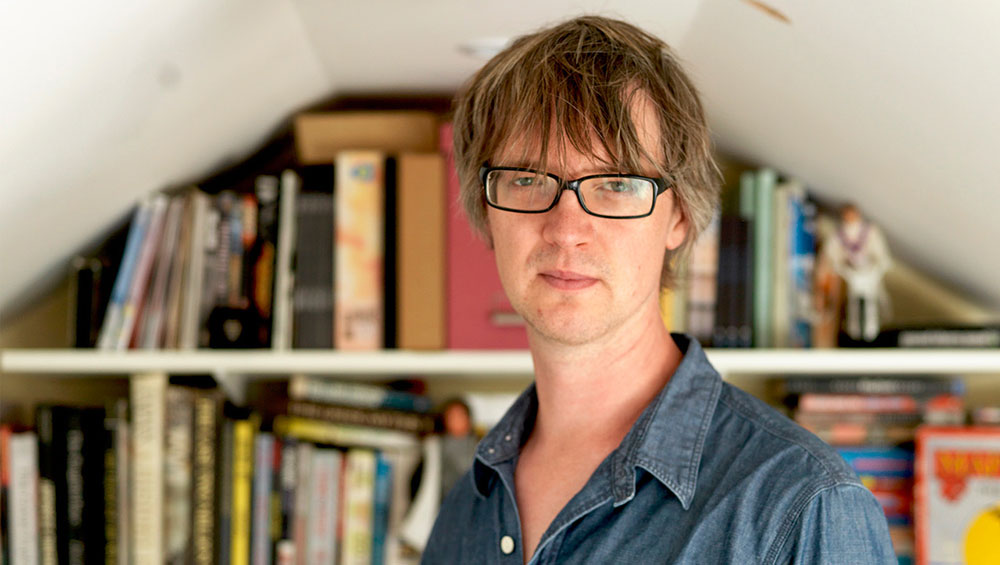
David Blandy. Photo: Claire Barrett.
by DAVID TRIGG
In the time of the Covid-19 pandemic, the internet has enabled many artists to continue making and exhibiting work in ways that would have been inconceivable just a few years ago. When the John Hansard Gallery at the University of Southampton approached David Blandy (b1976, London) to make new work for its website, the UK lockdown was about to be imposed, and so the British artist turned to internet culture for inspiration.
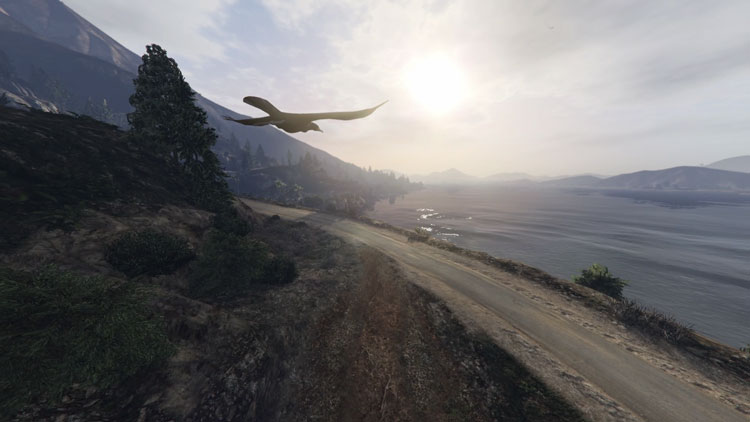
David Blandy. How to Fly, 2020 (still). Digital video. © the artist.
Blandy is known for films, installations and performances inspired by popular culture that question our relationship with the dominant narratives that form and shape our cultural identities. His new videos How to Fly and How to Live follow the form of online YouTube tutorials. Harnessing visuals from the video game Grand Theft Auto V, How to Fly shows a cormorant gliding through a canyon at sunrise. As the bird soars and swoops, Blandy contemplates the creature’s spiritual significance as a symbol of resourcefulness and bravery, although his new age monologue is collaged from texts found on the internet. How to Live purports to be a tutorial on how to use Adobe After Effects to bring static images to life, but it quickly becomes a visually rich meditation on the nature of life on Earth and humanity’s potential future. Made specifically for audiences under lockdown, the videos respond to global uncertainty, reflecting a deep desire for freedom and change.

David Blandy. How to Live, 2020 (still). Digital video. © the artist.
In addition to video games and YouTube sub-genres, explorations of race and identity have been at the forefront of Blandy’s multidisciplinary practice since his earliest works. His Passage of the Soul trilogy (2001-02), for instance, saw him lip-synching to tracks by black artists such as Syl Johnson, Ben E King and Wu-Tang Clan. The legacy of cultural appropriation was addressed again in Crossroads (2008), an ambitious film and installation focusing on the mythology surrounding legendary bluesman Robert Johnson. These themes are examined further in his collaborations with the British artist Larry Achiampong, which deal explicitly with the intersection of popular culture and postcolonial legacies.
David Blandy, From the Underground, (Passage of the Soul, Part I), 2001
Blandy and Achiampong’s Finding Fanon trilogy (2015-17) is inspired by the lost plays of Frantz Fanon (1925–1961), a French West Indian psychiatrist and political radical whose writings deal with the psychological impact of colonisation and the sociocultural consequences of decolonisation. In the trilogy, the two artists negotiate Fanon’s ideas through a personal lens, melding found text and autobiographical testimony to examine the politics of race, racism and the postcolonial position. After the recent death of George Floyd – an African American killed by a white Minneapolis police officer – sparked worldwide protests and renewed conversations about race, the Finding Fanon trilogy remains as relevant, if not more so, today than when it was first produced.
-Larry-Achiampong-&-David-Blandy-Image-by_Claire-Barrett.jpg)
David Blandy & Larry Achiampong. Finding Fanon 2015 (PR shot 3). Photo: Claire Barrett.
Blandy spoke to Studio International about his new films produced during lockdown, using video games to produce art, his collaborations with Achiampong and his thoughts about the present sociopolitical moment in which issues of racism and justice have been thrust back on to the agenda.
David Trigg: Your new videos How to Fly and How to Live (both 2020) were made specifically to be viewed at home under lockdown during the Covid-19 pandemic. How did this very specific context inform your approach?
David Blandy: I live with my partner and our two kids, so the lockdown has involved juggling home schooling, statutory exercise and the simple joy of being together, but also overwhelming anxiety – not only about how our family will survive, but how others are going to cope during and after the pandemic. In some ways, How to Fly reflected the first stage of lockdown, trying to find a safe space and escape in the midst of frightening change, whereas How to Live became a plea for the world to change and resist the many calls for everything to return to “normal”, a normal that has for a long time been so toxic for so many.
DT: Both works take YouTube tutorials as their starting point. What interests you about this aspect of internet culture?
DB: YouTube tutorials are a phenomenon. I’m self-taught in all the computer programs I use, and I first came across these tutorials while trying to learn various software techniques. But what fascinated me most about them was the very intimate tone of voice, like a cross between a teacher and a friend. Many are designed to attract subscribers, but others are made purely out of a desire to help people. There’s something very generous there, just sharing information on incredibly esoteric stuff with no expectation of reward.
DT: I first saw you explore this format in How to Make a Short Video About Extinction (2014), which examines various ways in which the world might end. Among the different scenarios – biotech disaster, meteor, solar flares, rogue black hole – one sticks out as being remarkably prescient: a highly contagious virus.
DB: That work began as a critique of a type of video art that was becoming quite popular at the time, where people were taking stuff from all over the internet to make assemblage videos without really engaging with the cultures they were appropriating. I think it’s important to have a true love for a cultural aesthetic or artefact before engaging with it, to approach it with a sense of reverence and understanding, otherwise it’s just exploitation. The video deconstructed its own production by mashing together a bunch of stuff and showing the viewer exactly how to do it. It was a pretty dark work about extinction, but I honestly never thought we’d see a global pandemic like the Spanish flu again, especially when recent outbreaks such as Sars and Mers seemed to be contained reasonably quickly. This was naive of me, of course.
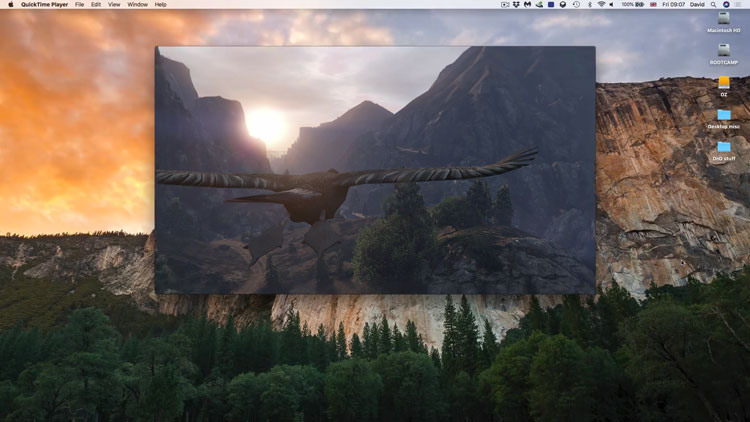
David Blandy. How to Fly, 2020 (still). Digital video. © the artist.
DT: What was the starting point for How to Fly?
DB: I wanted to make a work about escape, freedom and change. I had two things in mind: a tutorial about how to use Grand Theft Auto V to create films, and a web page about the spiritual significance of animals – a text that just seemed to fit this moment. John Hansard Gallery approached me to make a new work for its website just as lockdown was coming into force at the end of March. I had limited time and knew I would also be limited in terms of equipment and opportunities for filming, so I decided to make two new works based on my previous Tutorial videos.
DT: The image of a cormorant flying free in a vast natural landscape is antithetical to the experience of most viewers, who were stuck inside, barely allowed to leave their homes during lockdown.
DB: Yes, that was my intention, to create a sense of soaring and escape when we were all locked in our homes. It was cathartic to make – escaping into Grand Theft Auto V for days to unlock the cormorant avatar (unlocking the animal avatars is only possible by going on an elaborate treasure hunt game inside the game’s “story mode”), then into the aural world of my microKORG synthesiser, then recording the vocals and trying to find a calmness that I certainly wasn’t feeling. Cormorants are incredible birds, built for both land and air; they’re liminal, on the edge of two worlds.
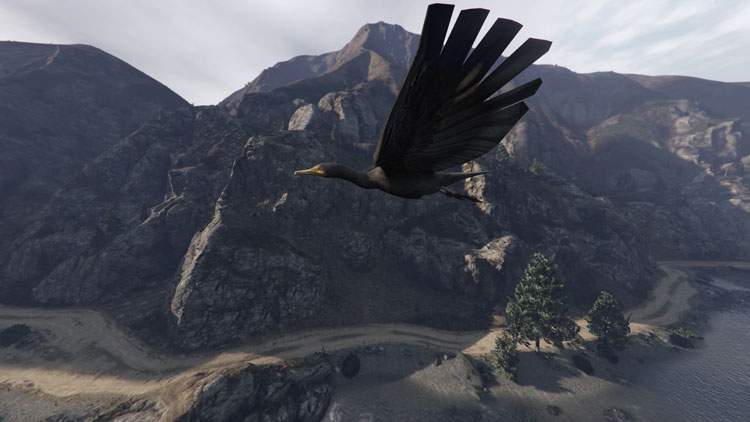
David Blandy. How to Fly, 2020 (still). Digital video. © the artist.
DT: The irony is that this cormorant and the world it inhabits is entirely virtual – a digital construction. It speaks to the type of armchair escapism that many have resorted to during lockdown, whether video games or other online content.
DB: I was thinking about the experience of lockdown, but also our condition as a culture, losing ourselves in virtual worlds. I don’t think that’s necessarily a bad thing. An experience of the sublime in the virtual realm is still an experience. Incredible communities have been formed online, which are affecting change in the physical world. On the surface, the virtual space is an escape, but dig into life there and the concerns of the real world remain. The online world can therefore be a space for transformation, a place for better understanding our offline existence.
DT: How to Fly contains a certain level of ambiguity; the script purports to be a cut-and-paste job, so it is hard to know how sincere you are being.
DB: My Tutorial works are based on taking a series of appropriated sources and putting them together to produce something that reflects on that appropriation, but also is totally sincere in sentiment. My fear of extinction is real. My belief in virtual connection is real. But I think there’s a white, English middle-class reserve that makes me have to wear a mask in order to say what I sincerely feel.
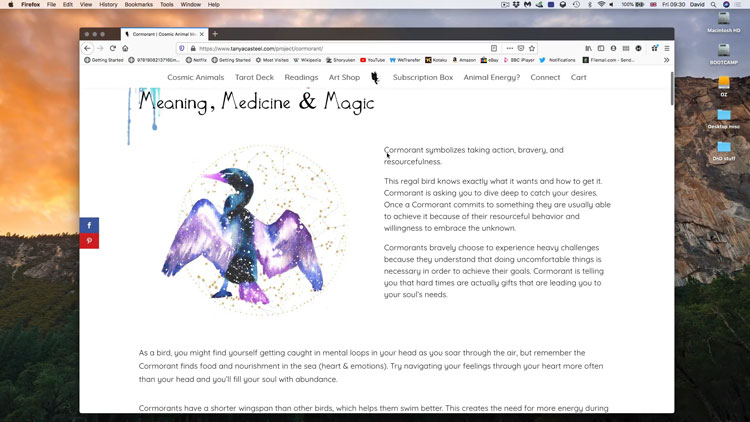
David Blandy. How to Fly, 2020 (still). Digital video. © the artist.
DT: This ambiguity is also felt in How to Live, which plays with the uncertainty of what is real and what is artifice. Much of the video’s imagery, which is brought to life by software, is an illusion, yet the narration assumes an authoritative tone, mixing stark scientific information with motivational musings on the nature of human existence.
DB: How to Live is a requiem and a manifesto. It is a search for a new form of communality from the detritus of the old digitality – a mix of wikiHow guides on how to live and scientific insights regarding the birth of life itself. Dead images sitting on servers are brought to life, transporting viewers into another space through the screen. It’s a work about the present moment, which is intricately bound up with all moments before and after – a moment that must be experienced fully if we are to understand and change our present condition.
Larry Achiampong & David Blandy. Finding Fanon Part Three: Prologue, Trailer, 2016
DT: How to Fly uses the virtual space of the video game Grand Theft Auto V, which you previously explored in your collaborations with Larry Achiampong: Finding Fanon Trilogy (2015-17) and FF Gaiden (2016-17). What led you to this way of working?
DB: Video games have influenced much of my work, from the creation of my alter-ego, the Barefoot Lone Pilgrim – inspired by Ryu, the main protagonist of the Street Fighter series – through to my Background project (2013), where I asked my father [the landscape artist John Blandy] to draw landscapes from the games I’ve played. I’ve been a gamer all my life, obsessed by clusters of pixels and the fantasy spaces made visible and interactive through the computer, so it felt natural to experiment with the possibilities offered by Grand Theft Auto V’s director mode. It’s a feature of the game that allows you to record a scene inside the game landscape, a space that encompasses beaches, mountains, forests and cities, and then view that scene from multiple angles with moving cameras, as though you have a huge camera crew. There’s a growing movement of film-makers producing these in-game movies – a genre called machinima.
DT: How did you begin working with Achiampong?
DB: In 2013, I filmed a performance at the Freud Museum called Biter, where I tried to remember hip-hop lyrics in Freud’s consulting room, bringing stories of black inner-city life to the father of psychoanalysis, in a consulting room adorned with hundreds of “ethnic” cultural artefacts. It sparked a conversation with Larry, who came to the screening at the Whitechapel gallery. We got talking and later met up at his studio. We got on really well, talking about hip-hop, video games, London life and sampling. It seemed a logical next step to try out the idea of mixing my (stolen) lyrics with his beats. Larry’s an incredible musician, and we set about forming a crew, The Biters. A biter is hip-hop slang for someone who steals rhymes, clothes, whatever, instead of coming up with their own stuff; we created a whole set out of mangled interpolations of hip-hop lyrics and re-sampled beats, taking the raw flavour to white cube spaces and music clubs across the country. The white cubes were very, very white, except for Iniva and Gallery 198 in Brixton, south London, which seemed like natural homes for the project. We were totally aware of the image we were creating, of black and white, a chessboard playing together yet also against one another, playing with ideas of cultural appropriation. But we ended up feeling that we were being perceived as entertainment; people were missing the nuanced critique at the heart of our performances. So, when Larry came to me with the story of Frantz Fanon’s lost plays, I could see that there was a metaphor in there that could help make our intentions more evident. Fanon was a psychiatrist, political philosopher and activist from Martinique who fought in the Algerian war of independence. He wrote extensively on the negative impacts of colonialism and wrote several plays that, until recently, were thought to be lost.
DT: But the trilogy doesn’t directly reference his plays, does it?
DB: No. We thought that the search for Fanon’s lost plays could represent a larger search for answers to the questions that he posed: how do we deal with the fact of individual and institutional racism, and how do we deal with the legacies of colonialism? So, Larry and I started making a film that showed us dressed as academics from the 1950s (an allusion to Jean-Paul Sartre and Fanon’s meeting in 1961) in an empty, post-apocalyptic landscape. The script contrasts our familial experiences of colonialism; Larry talks of his uncle’s experience in asylum detention centres in the early 1980s and I speak of my grandfather’s involvement as a horticulturist in Kenya just before the end of British rule. My grandfather was posted to Kenya as part of the Swynnerton Plan, growing pineapples – a plant from south America that was to be grown as a cash-crop to be tinned and sent back to England, bolstering the black middle class and repressing the Mau Mau uprising. It didn’t work, and my grandfather escaped the rising anti-colonial violence, leading to a similar misadventure in Burma.
-Larry-Achiampong-&-David-Blandy-Image-by_Claire-Barrett.jpg)
David Blandy & Larry Achiampong. Finding Fanon 2015 (PR shot 1). Photo: Claire Barrett.
Q. The Finding Fanon project was an important development for both of your practices. It feels even more relevant now in light of the recent Black Lives Matter protests and the tearing down of Edward Colston’s statue in Bristol. There is a chilling line in the second part of the trilogy: “Here we are, so very near to the edge of the cliff; the line in the road; the invisible wall in the video game. Like the terrorised animal forced to the corner, we must fight back. Why? It is simple: we can no longer breathe.”
DB: When we were working on Finding Fanon Part One (2015), Eric Garner’s death, in a horribly similar manner to George Floyd’s, was very much on our minds. Larry made a pilgrimage to New York to see the shrine that was set up as a memorial to Garner and there is footage of it in the film. I hate that nothing seems to have changed since then, but I think the current protests and debates are a positive sign that the history of racism in Britain is finally being taken seriously. But why didn’t this happen after Stephen Lawrence? After Mark Duggan? After Grenfell? After Brexit? In 2009, when I exhibited my Crossroads film and installation at Spike Island in Bristol, Colston’s statue was very much at the centre of debates around the legacy of slavery in the city. Nothing was done. People have been demanding change for decades, trying all legal means yet stymied at every turn by everyday and institutionalised racism. We’ve never truly acknowledged the evils of empire, only glorified it, pretending that we were free from slavery when, economically, the British Empire was built on it. These are stories and histories that need to be told. Stuart Hall, the Jamaican-born sociologist, cultural theorist and activist, always talked of living with difference and, through hybridity, forming an “unfinished conversation” across cultures and generations. This is where we stand now. We either face up to the reality of difference and move forward, or lose ourselves in the myth of a monocultural past. My works with Larry have always been a call for change, while pinpointing the difficulties of the present.
DT: How does the collaboration with Larry work?
DB: It’s really organic. We build up ideas through conversations across platforms, in WhatsApp, Instagram direct messages, texts, phone calls and meeting up at events and studios. We live in different cities and operate best at different times of day, so it works well posting little messages across the ether to the keep the conversation going. Larry composes most of the music and I am the primary video editor, chucking everything together, choosing pace, cuts and juxtapositions. For a few great months, we did a residency at Wysing Arts Centre in Cambridge where we were able to collaborate more directly in the same room for an extended length of time, composing the score for Finding Fanon Part Three together and making shared editing decisions. We have also collaborated with others. Finding Fanon Part One and Part Three were made in collaboration with my partner, Claire Barrett, who did the cinematography. The voiceovers on the Finding Fanon Trilogy were a collaboration with the mother of Larry’s children, Hayleigh-Joy Rose. Both Claire and Hayleigh-Joy I think added an extra dimension to the films, bringing the female gaze and voice to the work, something we were conscious would otherwise be missing from the story.
.jpg)
David Blandy. FF Gaiden delete, 2016. © the artist.
DT: Your research into Frantz Fanon spawned the FF Gaiden series (2016-17), in which you combine computer game visuals with the stories of migrants, refugees, prisoners and other marginalised figures. FF Gaiden: Delete (2016), which is currently featured in the Arts Council Collection’s online exhibition Stay Home: Art in Uncertain Times, focuses on the stories of three paperless migrants living in Norway. How did this film come about?
DB: Gaiden is a term from Japanese pop culture meaning “side-story”, where different characters come to the fore in the same universe. We began the FF Gaiden series while working within the criminal justice system as part of a project run by FACT at HMP Altcourse in Liverpool. We wanted to make a work with veterans in prison and their families, but cameras were not permitted. Eventually, we persuaded them to allow a PlayStation 4, and we knew that, using the techniques we had developed for Finding Fanon Part Two, we could create a space for them to talk and tell their own story. What we ended up with was a collection of short films that spoke poetically and directly about freedom, imprisonment and masks of the human condition. Soon after, we were offered a residency in Oslo at PRAKSIS, where we worked with Mennesker i Limbo, a group for paperless migrants. It felt vital to continue the process and tell their stories about migration, cultural history and social change.
DT: The use of video game imagery and computer-generated speech presents these personal testimonies at a remove, reminding us that so much of our experience and understanding of the world is mediated. It also underscores the vast chasm between our comfortable western lives and the horrendous experiences that so many people endure in different parts of the world. Are you concerned that the virtual nature of the films risks undermining the reality of your subjects’ suffering?
DB: The digital space became, quite literally, a safe space for them to talk freely; the avatars and computer voices becoming like masks for them to wear in order to speak without fear. It was a question of safety. One of the migrants, Sara, had relatives back in Eritrea who were at risk of repercussions from her talking with us. It was a very delicate process. They were, of course, worried about the authorities in Oslo, too. Paperless migrants have no right to work, no right to education or access to health services, and it was important to make the implications of all that feel real. Obviously, this situation is ongoing and is also happening in the UK. Coronavirus is only going to make things worse as they have no rights or access to public funding or help. In the case of FF Gaiden: Delete, I think something very particular happens – the cold computer voice and stilted animation actually forces viewers to listen more intently, to understand the words rather than blank them out as just another testimony.
DT: Much of your work is designed for gallery display, yet your latest videos have been made available for home viewing. What is at stake in allowing works to exist beyond the conventional strictures of the art world?
DB: Context changes work. That’s just a fact that artists have to come to terms with. I try to make videos that function in all contexts, from projection in a specifically constructed installation to a mobile phone screen. Some works make the transition better than others and I’m always happy when films successfully transition to a smaller screen, perhaps even slipping into another realm of culture – into the streams for “How to” videos or machinima. Art is not entertainment, it won’t go viral or garner huge subscriber numbers, but it may touch a few people who would never step inside a gallery or museum. I’m willing to enter into that possibility even if it dilutes ideas of “exclusivity” that seem so important to certain sectors of the art world. Art is for everyone. That’s why I have loads of my work on my website and Vimeo page, and am accessible through Instagram and Twitter. The conversation never ends.
Larry Achiampong and David Blandy’s FF Gaiden: Delete is included in the Arts Council Collection’s online exhibition Stay Home: Art in Uncertain Times.